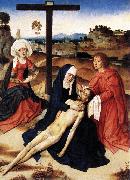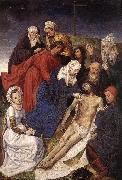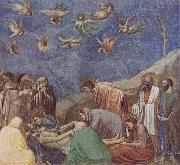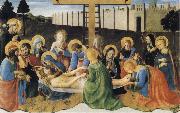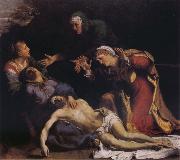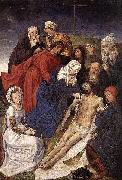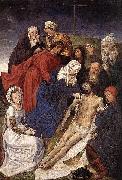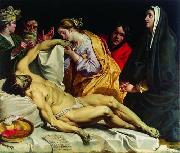Wholesale Oil Painting No Minimum |
|||||||||||
|
|
|||||||||||

|
|||||||||||
|
|
|
||||||||
Jaime Huguet1415-1492 French Jaime Huguet Galleries |
||||||||
|
|
||||||||
The Lamentation of Christ
The Lamentation of Christ Painting ID:: 2262 |
The Lamentation of Christ The Lamentation of Christ |
|||||||
|
|
||||||||
Dieric Bouts1420-1475 Flemish Dieric Bouts Locations Dirk Bouts whose real name was Theodorik Romboutszoon, was probably born in Haarlem, where he may have studied under the painter Albert van Ouwater. Sometime before 1450 Bouts took up residence in the Flemish city of Louvain. His name appeared in the records of Louvain in 1457 and again in 1468, when he was appointed "city painter." It is likely that Bouts spent some time in Bruges, as his earliest work, the Infancy Altarpiece shows the distinct and strong influence of Petrus Christus, the leading master of that city after the death of Jan van Eyck. The slightly later Deposition Altarpiece (ca. 1450) displays strong connections with the style of Rogier van der Weyden in both the figure types and the composition. About 1460, the period of the Entombment in London, the early, formative influence of Petrus Christus had been almost totally displaced by that of Rogier, though Bouts personal vision began to emerge in the fluid and continuous landscape background. The great Last Supper Altarpiece (1464-1467) marks the high point of Bouts career. In this solemn and dignified masterpiece the painter achieved spiritual grandeur in the context of convincing physical reality. The central panel of the altarpiece is the most emphatically significant treatment of the theme of the Last Supper in Northern European art. The wings, which contain Old Testament prefigurations of the central theme, are freer and more loosely organized. Eschewing the symmetry and rigid axial construction of the main panel, Bouts produced rhythmic foreground compositions in combination with fluid and dramatic spatial recessions. In 1468 Bouts was commissioned to paint four panels on the subject of justice for the Town Hall of Louvain. At the painter death in 1475 only two of the paintings had been completed; they are among the most remarkable productions of his career. The unusual subjects, taken from the chronicles of a 12th-century historian, concern the wrongful execution by Emperor Otto III of one of his counts and the subsequent vindication of the nobleman by his wife. The finer of the panels represents the dramatic trial by fire which the wife was obliged to undergo to prove her husband innocence. Rich draperies and sumptuous colors are applied to tall angular forms to create a work of rare formal elegance and high decorative appeal. In order to dignify the event, however, the artist has employed restrained gestures and expressions as well as a completely rationalized spatial setting. As in the Last Supper Altarpiece, a sense of solemn and hieratic importance is expressed by means of an austere and rigid geometry in the construction of both persons and places. The late productions of Bouts workshop, such as the well-known Pearl of Brabant Altarpiece, are characterized by the close collaboration of the painter two sons, Dirk the Younger (1448-1491) and Aelbrecht (1455/1460-1549). In the paintings of his less gifted sons, the master distinctive figure style was appreciably altered, though Dirk the Younger appears to have retained much of his father sensitivity to the landscape. In addition to his innovations in the depiction of landscape, Bouts made a substantial contribution to the development of the portrait. His Portrait of a Man (1462) localizes the sitter in an enlarged architectural setting while permitting the interior space to merge with the exterior through an open window. For the first time in Northern painting a common bond was forged between a particularized individual and the universal world of nature. |
||||||||
|
|
||||||||
|
|
The Lamentation of Christ
The Lamentation of Christ Painting ID:: 10032 |
c. 1460
Oil on wood,
69 x 49 cm Louvre c. 1460 Oil on wood, 69 x 49 cm Louvre |
||||||
|
|
||||||||
Hugo van der Goes1440-1482 Flemish Hugo van der Goes Galleries Hugo became a member of the painters' guild of Ghent as a master in 1467. In 1468 he was involved in the decoration of the town of Bruges in celebration of the marriage between Charles the Bold and Margaret of York and he provided heraldic decorations for Charles's joyeuse entr??e to Ghent in 1469 and again in 1472. He was elected dean of the Ghent guild in 1473 or 1474. In 1475, or some years later, Hugo entered Rooklooster, a monastery near Brussels belonging to the Windesheim Congregation, and professed there as a frater conversus. He continued to paint, and remained at Rooklooster until his death in 1482 or 1483. In 1480 he was called to the town of Leuven to evaluate the Justice Scenes left unfinished by the painter Dieric Bouts on his death in 1475. Shortly after this, Hugo, returning with other members of his monastery from a trip to Cologne, fell into a state of suicidal gloom, declaring himself to be damned. After returning to Rooklooster, Hugo recovered from his illness, and died there. His time at Rooklooster is recorded in the chronicle of his fellow monk, Gaspar Ofhuys. A report by a German physician, Hieronymus M??nzer, from 1495, according to which a painter from Ghent was driven to melancholy by the attempt to equal the Ghent Altarpiece, may refer to Hugo. His most famous surviving work is the Portinari Triptych (Uffizi, Florence), an altarpiece commissioned for the church of San Egidio in the hospital of Santa Maria Nuova in Florence by Tommaso Portinari, the manager of the Bruges branch of the Medici Bank. The triptych arrived in Florence in 1483, apparently some years after its completion by van der Goes. The largest Netherlandish work that could be seen in Florence, it was greatly praised. Giorgio Vasari in his Vite of 1550 referred to it as by "Ugo d'Anversa" ("Hugo of Antwerp"). This the sole documentation for its authorship by Hugo; other works are attributed to him based on stylistic comparison with the altarpiece. Hugo appears to have left a large number of drawings, and either from these or the paintings themselves followers made large numbers of copies of compositions that have not survived from his own hand. A drawing of Jacob and Rachel preserved at Christ Church, Oxford is thought to be a rare surviving autograph drawing. |
||||||||
|
|
||||||||
|
|
The Lamentation of Christ
The Lamentation of Christ Painting ID:: 10046 |
1467-68
Oil on oak,
33,8 x 23 cm
Kunsthistorisches
Museum, Vienna 1467-68 Oil on oak, 33,8 x 23 cm Kunsthistorisches Museum, Vienna |
||||||
|
|
||||||||
GOES, Hugo van derNetherlandish Northern Renaissance Painter, ca.1440-1482 South Netherlandish painter. In 1467 he enrolled as master in the Ghent painters' guild, sponsored by Joos van Wassenhove, master painter in Ghent in 1464 after registering in Antwerp in 1460. In 1469 the two together acted as guarantors for the illuminator Sanders Bening when he became a master, and it was from Hugo that Joos borrowed money when he went to Rome. Sanders Bening was married to Kathelijn van der Goes, perhaps Hugo's sister. Hugo's status within the guild is further attested by the fact that he was guarantor for two other painters in 1471 and 1475, that he was one of the dean's jurors in 1468-9 and that he himself served as dean from towards the end of 1473-4 to at least 18 August 1475. |
||||||||
|
|
||||||||
|
|
The Lamentation of Christ
The Lamentation of Christ Painting ID:: 31288 |
1467-68
Oil on oak, 33,8 x 23 cm
Kunsthistorisches Museum, Vienna 1467-68 Oil on oak, 33,8 x 23 cm Kunsthistorisches Museum, Vienna |
||||||
|
|
||||||||
GIOTTO di BondoneItalian Early Renaissance Painter, 1267-1337 Italian painter and designer. In his own time and place he had an unrivalled reputation as the best painter and as an innovator, superior to all his predecessors, and he became the first post-Classical artist whose fame extended beyond his lifetime and native city. This was partly the consequence of the rich literary culture of two of the cities where he worked, Padua and Florence. Writing on art in Florence was pioneered by gifted authors and, although not quite art criticism, it involved the comparison of local artists in terms of quality. The most famous single appreciation is found in Dante's verses (Purgatory x) of 1315 or earlier. Exemplifying the transience of fame, first with poets and manuscript illuminators, Dante then remarked that the fame of Cimabue, who had supposed himself to be the leader in painting, had now been displaced by Giotto. Ironically, this text was one factor that forestalled the similar eclipse of Giotto's fame, which was clearly implied by the poet. |
||||||||
|
|
||||||||
|
|
The Lamentation of Christ
The Lamentation of Christ Painting ID:: 33311 |
mk86
1303-1305
Fresco
185x200cm
Padua,Arena Chapel
mk86 1303-1305 Fresco 185x200cm Padua,Arena Chapel |
||||||
|
|
||||||||
Fra AngelicoFra Angelico Galleries b.c. 1400, Vicchio, Florence d.Feb. 18, 1455, Rome Fra Angelico (c. 1395 ?C February 18, 1455), born Guido di Pietro, was an Early Italian Renaissance painter, referred to in Vasari's Lives of the Artists as having "a rare and perfect talent". Known in Italy as il Beato Angelico, he was known to his contemporaries as Fra Giovanni da Fiesole (Brother John from Fiesole). In Giorgio Vasari's Lives of the Artists, written prior to 1555, he was already known as Fra Giovanni Angelico (Brother Giovanni the Angelic One). Within his lifetime or shortly thereafter he was also called Il Beato (the Blessed), in reference to his skills in painting religious subjects. In 1982 Pope John Paul II conferred beatification, thereby making this title official. Fiesole is sometimes misinterpreted as being part of his formal name, but it was merely the name of the town where he took his vows, used by contemporaries to separate him from other Fra Giovannis. He is listed in the Roman Martyrology as Beatus Ioannes Faesulanus, cognomento Angelicus??"Blessed Giovanni of Fiesole, nicknamed Angelico". Fra Angelico was working at a time when the style of painting was in a state of change. This process of change had begun a hundred years previous with the works of Giotto and several of his contemporaries, notably Giusto de' Menabuoi, both of whom had created their major works in Padua, although Giotto was trained in Florence by the great Gothic artist, Cimabue, and painted a fresco cycle of St Francis in the Bardi Chapel in Santa Croce. Giotto had many enthusiastic followers, who imitated his style in fresco, some of them, notably the Lorenzetti, achieving great success. |
||||||||
|
|
||||||||
|
|
The Lamentation of Christ
The Lamentation of Christ Painting ID:: 33348 |
mk86
1436
Tempera on wood
108x165cm
Florence,Museo di San Marco
mk86 1436 Tempera on wood 108x165cm Florence,Museo di San Marco |
||||||
|
|
||||||||
Annibale Carracci1560-1609 Italian Annibale Carracci Locations Painter, draughtsman and printmaker, brother of (2) Agostino Carracci. Since his lifetime, he has been considered one of the greatest Italian painters of his age. His masterpiece, the ceiling (1597-1601) of the Galleria Farnese, Rome, merges a vibrant naturalism with the formal language of classicism in a grand and monumental style. Annibale was also instrumental in evolving the ideal, classical landscape and is generally credited with the invention of CARICATURE. |
||||||||
|
|
||||||||
|
|
The Lamentation of Christ
The Lamentation of Christ Painting ID:: 33566 |
mk86
1606
Oil on canvas
92.8x103.2cm
London,National Gallery
mk86 1606 Oil on canvas 92.8x103.2cm London,National Gallery |
||||||
|
|
||||||||
Hugo van der Goes1440-1482 Flemish Hugo van der Goes Galleries Hugo became a member of the painters' guild of Ghent as a master in 1467. In 1468 he was involved in the decoration of the town of Bruges in celebration of the marriage between Charles the Bold and Margaret of York and he provided heraldic decorations for Charles's joyeuse entr??e to Ghent in 1469 and again in 1472. He was elected dean of the Ghent guild in 1473 or 1474. In 1475, or some years later, Hugo entered Rooklooster, a monastery near Brussels belonging to the Windesheim Congregation, and professed there as a frater conversus. He continued to paint, and remained at Rooklooster until his death in 1482 or 1483. In 1480 he was called to the town of Leuven to evaluate the Justice Scenes left unfinished by the painter Dieric Bouts on his death in 1475. Shortly after this, Hugo, returning with other members of his monastery from a trip to Cologne, fell into a state of suicidal gloom, declaring himself to be damned. After returning to Rooklooster, Hugo recovered from his illness, and died there. His time at Rooklooster is recorded in the chronicle of his fellow monk, Gaspar Ofhuys. A report by a German physician, Hieronymus M??nzer, from 1495, according to which a painter from Ghent was driven to melancholy by the attempt to equal the Ghent Altarpiece, may refer to Hugo. His most famous surviving work is the Portinari Triptych (Uffizi, Florence), an altarpiece commissioned for the church of San Egidio in the hospital of Santa Maria Nuova in Florence by Tommaso Portinari, the manager of the Bruges branch of the Medici Bank. The triptych arrived in Florence in 1483, apparently some years after its completion by van der Goes. The largest Netherlandish work that could be seen in Florence, it was greatly praised. Giorgio Vasari in his Vite of 1550 referred to it as by "Ugo d'Anversa" ("Hugo of Antwerp"). This the sole documentation for its authorship by Hugo; other works are attributed to him based on stylistic comparison with the altarpiece. Hugo appears to have left a large number of drawings, and either from these or the paintings themselves followers made large numbers of copies of compositions that have not survived from his own hand. A drawing of Jacob and Rachel preserved at Christ Church, Oxford is thought to be a rare surviving autograph drawing. |
||||||||
|
|
||||||||
|
|
The Lamentation of Christ
The Lamentation of Christ Painting ID:: 83100 |
Date between 1467(1467) and 1468(1468)
Medium Oil on oak
Dimensions Height: 33.8 cm (13.3 in). Width: 23 cm (9.1 in).
cjr Date between 1467(1467) and 1468(1468) Medium Oil on oak Dimensions Height: 33.8 cm (13.3 in). Width: 23 cm (9.1 in). cjr |
||||||
|
|
||||||||
Hugo van der Goes1440-1482 Flemish Hugo van der Goes Galleries Hugo became a member of the painters' guild of Ghent as a master in 1467. In 1468 he was involved in the decoration of the town of Bruges in celebration of the marriage between Charles the Bold and Margaret of York and he provided heraldic decorations for Charles's joyeuse entr??e to Ghent in 1469 and again in 1472. He was elected dean of the Ghent guild in 1473 or 1474. In 1475, or some years later, Hugo entered Rooklooster, a monastery near Brussels belonging to the Windesheim Congregation, and professed there as a frater conversus. He continued to paint, and remained at Rooklooster until his death in 1482 or 1483. In 1480 he was called to the town of Leuven to evaluate the Justice Scenes left unfinished by the painter Dieric Bouts on his death in 1475. Shortly after this, Hugo, returning with other members of his monastery from a trip to Cologne, fell into a state of suicidal gloom, declaring himself to be damned. After returning to Rooklooster, Hugo recovered from his illness, and died there. His time at Rooklooster is recorded in the chronicle of his fellow monk, Gaspar Ofhuys. A report by a German physician, Hieronymus M??nzer, from 1495, according to which a painter from Ghent was driven to melancholy by the attempt to equal the Ghent Altarpiece, may refer to Hugo. His most famous surviving work is the Portinari Triptych (Uffizi, Florence), an altarpiece commissioned for the church of San Egidio in the hospital of Santa Maria Nuova in Florence by Tommaso Portinari, the manager of the Bruges branch of the Medici Bank. The triptych arrived in Florence in 1483, apparently some years after its completion by van der Goes. The largest Netherlandish work that could be seen in Florence, it was greatly praised. Giorgio Vasari in his Vite of 1550 referred to it as by "Ugo d'Anversa" ("Hugo of Antwerp"). This the sole documentation for its authorship by Hugo; other works are attributed to him based on stylistic comparison with the altarpiece. Hugo appears to have left a large number of drawings, and either from these or the paintings themselves followers made large numbers of copies of compositions that have not survived from his own hand. A drawing of Jacob and Rachel preserved at Christ Church, Oxford is thought to be a rare surviving autograph drawing. |
||||||||
|
|
||||||||
|
|
The Lamentation of Christ
The Lamentation of Christ Painting ID:: 87249 |
between 1467(1467) and 1468(1468)
Medium Oil on oak
cyf between 1467(1467) and 1468(1468) Medium Oil on oak cyf |
||||||
|
|
||||||||
Abraham Janssensvan Nuyssen (ca. 1567/1576 - 1632) was a Flemish Baroque painter. He was born at Antwerp, in a year variously reported between 1567 and 1576. He studied under Jan Snellinck, was a master in 1602, and in 1607 was dean of the master-painters. He died in the city of his birth. Till the appearance of Rubens he was considered perhaps the best historical painter of his time. The styles of the two artists are not unalike. In correctness of drawing Janssens excelled his great contemporary; in bold composition and in treatment of the nude he equalled him; but in faculty of color and in general freedom of disposition and touch he fell far short. A master of chiaroscuro, he gratified his taste for strong contrasts of light and shade in his torchlights and similar effects. Good examples of this master are to be seen in the Antwerp museum and the Vienna gallery. The stories of his jealousy of Rubens and of his dissolute life are quite unfounded. His students include Gerard Seghers and Theodoor Rombouts. |
||||||||
|
|
||||||||
|
|
The Lamentation of Christ
The Lamentation of Christ Painting ID:: 88300 |
c. 1624(1624)
Medium Oil on canvas
Dimensions 155 x 180.5 cm (61 x 71.1 in)
cyf c. 1624(1624) Medium Oil on canvas Dimensions 155 x 180.5 cm (61 x 71.1 in) cyf |
||||||
|
|
||||||||
|
Abraham Janssens van Nuyssen (ca. 1567/1576 - 1632) was a Flemish Baroque painter. He was born at Antwerp, in a year variously reported between 1567 and 1576. He studied under Jan Snellinck, was a master in 1602, and in 1607 was dean of the master-painters. He died in the city of his birth. Till the appearance of Rubens he was considered perhaps the best historical painter of his time. The styles of the two artists are not unalike. In correctness of drawing Janssens excelled his great contemporary; in bold composition and in treatment of the nude he equalled him; but in faculty of color and in general freedom of disposition and touch he fell far short. A master of chiaroscuro, he gratified his taste for strong contrasts of light and shade in his torchlights and similar effects. Good examples of this master are to be seen in the Antwerp museum and the Vienna gallery. The stories of his jealousy of Rubens and of his dissolute life are quite unfounded. His students include Gerard Seghers and Theodoor Rombouts. The Lamentation of Christ c. 1624(1624) Medium Oil on canvas Dimensions 155 x 180.5 cm (61 x 71.1 in) cyf |
||||||||
|
|
||||||||
|
Prev Next
|
||||||||
|
|
||||||||
|
Related Paintings to Abraham Janssens :. |
||||||||
|
|
||||||||
|
CONTACT US |


